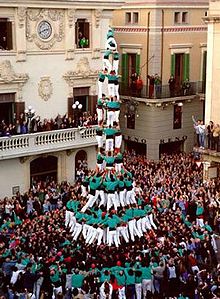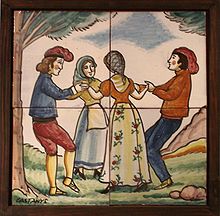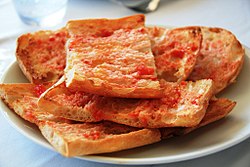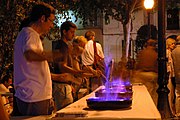
Catalan cuisine is the cuisine from Catalonia. It may also refer to the shared cuisine of Northern Catalonia and Andorra, the second of which has a similar cuisine to that of the neighbouring Alt Urgell and Cerdanya comarques and which is often referred to as "Catalan mountain cuisine". It is considered a part of western Mediterranean cuisine.

Valls is a city and municipality in the Camp de Tarragona region in Catalonia, Spain. It is the capital of the comarca of Alt Camp. In 2014, it had a population of 24,570.
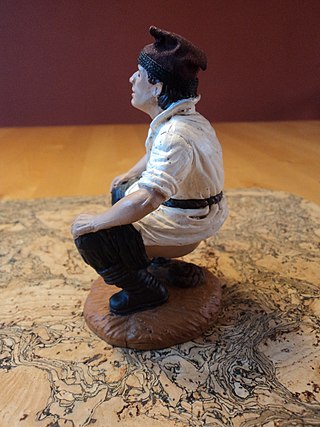
A Caganer is a figurine depicted in the act of defecation appearing in nativity scenes in Catalonia and neighbouring areas such as Andorra, Valencia, Balearic Islands, and Northern Catalonia. It is most popular and widespread in these areas, but can also be found in other areas of Spain (Murcia), Portugal, and Southern Italy (Naples).

The Costa Brava is a coastal region of Catalonia in northeastern Spain. Sources differ on the exact definition of the Costa Brava. Usually it can be regarded as stretching from the town of Blanes, 60 km (37 mi) northeast of Barcelona, to the French border – in other words it consists of the coast of the province of Girona.

L'Escala is a municipality in the comarca of the Alt Empordà in Girona, Catalonia, Spain. It is situated on the Costa Brava, located between the southern end of the Gulf of Roses and Cala (bay) Montgó. It is an important fishing port and tourist centre, and has a festival dedicated to its famous anchovies. The GE-513 road runs inland from the town.

Vilanova i la Geltrú is the capital city of Garraf comarca, in the province of Barcelona, Catalonia, Spain. Historically, it is the result of the aggregation of the medieval center of La Geltrú with the center built outside the medieval walls, Vilanova. Initially, the lands of Vilanova belonged to Cubelles, the neighboring town. The city of Vilanova i la Geltrú has a growing population of approximately 66,000, and is situated 40 km south-west of Barcelona, with the coastal resort of Sitges some 10 km to the north-east.

Sant Sadurní d'Anoia is a municipality in the comarca of the Alt Penedès in Catalonia, Spain; and the centre of production of a sparkling wine known as cava. It is situated in the north-east of the Penedès Depression at the confluence of the Avernó river and the Anoia river. It is made accessible by the A-7 autopista and the Renfe railway line (R4) that connect Barcelona with Manresa and El Vendrell.

Sant Feliu de Guíxols is a municipality in the comarca of the Baix Empordà in Catalonia, Spain. It is situated on the Costa Brava and is an important port and tourist centre. The district abuts to the north, the upmarket s'Agaró resort built round the Sant Pol Beach. In addition to tourism and the port the cork industry is a traditionally local industry. The town contains a large monastery which now houses the town museum and is a protected historico-artistic monument.

Esporles is a locality and Spanish municipality of the autonomous community of the Balearic Islands. Situated on the island of Majorca, around the zone of the Serra de Tramuntana. It's about 15 km from Palma de Mallorca. The town is divided into Vilavella and Vilanova. In its territory it also includes small urbanizations, like Ses Rotgetes de Canet y Es Verger.
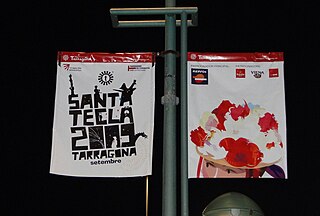
The Santa Tecla Festival is a festival held in Tarragona, Catalonia, Spain.

La Mercè is the annual festival of the city of Barcelona in Catalonia, Spain. It has been an official city holiday since 1871, when the local government first organized a program of special activities to observe the Roman Catholic feast day of Our Lady of Mercy, La Mare de Déu de la Mercè in Catalan. Although the actual feast day is September 24, the festivities begin a few days beforehand.
Vilanova International World Music Festival is a multicultural festival of music, workshops and conferences, that takes place every year on the third weekend of July, in Vilanova i la Geltrú, in Catalonia, Spain. Started in 1981, it is the oldest world music festival in Catalonia, and also in Spain, having been far ahead of its time. The festival lasts for three days, from 11 o’clock in the morning until night. There are more than thirty activities for children and adults. Most of the performances in this event are free.

The national symbols of Catalonia are flags, icons or cultural expressions that are emblematic, representative or otherwise characteristic of Catalonia or Catalan culture.

The following outline is provided as an overview of and topical guide to Catalonia:

The Catalan Way, also known as the Catalan Way towards Independence, was a 400-kilometre (250 mi) human chain in support of Catalan independence from Spain. It was organized by the Assemblea Nacional Catalana (ANC) and supported by 14 nongovernmental groups. It took place in Catalonia on 11 September 2013, which is the National Day of Catalonia, known as Diada. Catalonia's Department of the Interior estimated the number of participants at about 1.6 million. The human chain followed the ancient Via Augusta, from Le Perthus up to Alcanar. According to Carme Forcadell, president of the ANC at that time, it was "a symbol of the unity of Catalan people to achieve national sovereignty".

The Castellers de Berga are a colla castellera, or human tower team, based in Berga with members from throughout El Berguedà and beyond. They were founded in 2012. Their shirt is navy blue. To date, the Castellers de Berga have achieved high-range seven-level constructions and on October 1, 2016, they achieved their first eight-level castell.

Saint George's Day is celebrated annually on April 23.
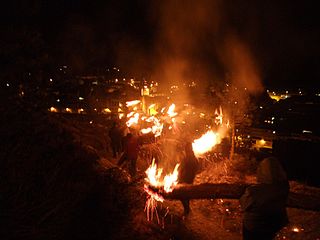
Fia-Faia is a Christmas tradition with pre-Christian roots celebrated on 24 December in the towns of Bagà and Sant Julià de Cerdanyola, Catalonia. The Government of Catalonia declared it a heritage festival of national interest on 16 November 2010. A few years later, in 2015, it was added to the UNESCO Intangible Cultural Heritage Lists together with the summer solstice fire festivals in the Pyrenees.
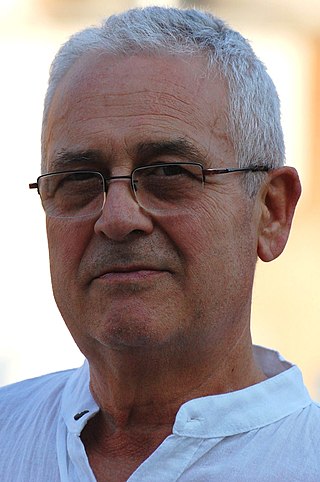
Joan Soler i Amigó was a Spanish writer and teacher.
The Day of Books and Roses, April 23, is celebrated in Catalonia, Spain. This day is also known as Diada de Sant Jordi in Catalan. On this day, love and literature are celebrated throughout Catalonia. Books and roses are exchanged.

